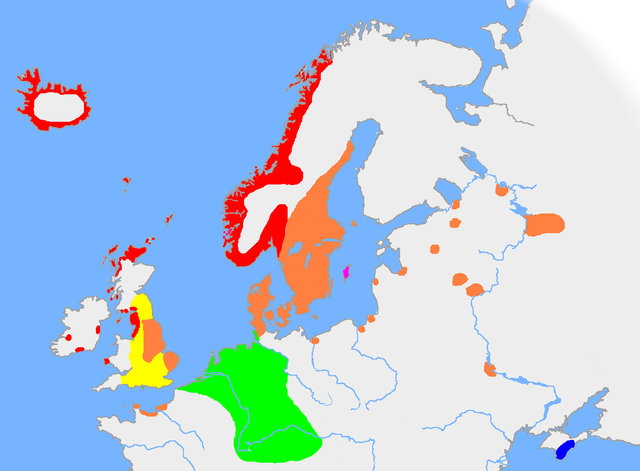
File:Old norse, ca 900.PNG

Size of this preview: 640 × 471 pixels.
| |
This is a file from the Wikimedia Commons. Information from its description page there is shown below.
Commons is a freely licensed media file repository. You can help. |
 |
This map image could be recreated using vector graphics as an SVG file. This has several advantages; see Commons:Media for cleanup for more information. If an SVG form of this image is already available, please upload it. After uploading an SVG, replace this template with {{ vector version available|new image name.svg}}. |
Summary
| Description |
English: The approximate extent of Old Norse and related languages in the early 10th century.
Esperanto: En la supra mapo pri la lingvodisdivido ĉirkaŭ la Norda Maro dum la jaro 900, la ruĝa kaj oranĝa koloroj estas la okcidenta kaj orienta varioj de la norena lingvo, violkoloras la gotlanda lingvo, flavas la anglosaksa en Britio, kaj inter la verdaj areoj estas la restaj varioj de la ĝermana lingvo, kun multe da saksa kaj marborde iom la frisa lingvoj en hodiaŭa norda Germanio kaj Nederlando. Krome bluas la krimee gota lingvo.
Français : Distribution géographique approximative du vieux norrois et des langues apparentées au début du Xe siècle. En rouge, le dialecte du scandinave occidental (ou vieux norrois proprement dit), en orange, le dialecte du scandinave oriental, en rose, le vieux utnisk, en jaune, le vieil anglais, et en vert, les autres langues germaniques avec lesquelles le vieux norrois conservait une certaine intercompréhension. En bleu, le dialecte gotique de Crimée.
Italiano: Distribuzione geografica dell'antico norreno e delle lingue ad esso collegate all'inizio del X secolo. L'area rossa è la zona di distribuzione del dialetto occidentale; l'area arancione quella del dialetto orientale. L'isola rosa il gutnico antico e l'area verde rappresenta l'estensione delle altre lingue germaniche con cui si ritiene che l'antico norreno abbia una certa mutua intelligibilità. L'area blu è la zona di distribuzione del dialetto gotico di Crimea.
Nederlands: Waarschijnlijke verspreiding van het Oudnoords en verwante talen in de vroege 10e eeuw. Het rode gebied omvat het Oudwestnoords; het oranje gebied het Oudoostnoords. In het roze gebied werd Oudgutnisch gesproken, in het gele het Oudengels, en het groene gebied toont andere West-Germaanse talen met welke het Oudnoords nog steeds onderling te begrijpen was. Het blauwe gebied toont de verbreiding van het Krim-Gotisch dialect.
Norsk bokmål: Utbredelsen av norrønt og beslektede språk på 900-tallet. Det røde feltet viser utbredelsen av dialekten vestnordisk, orange av østnordisk, rosa av gammalgutnisk, blått av krimgotisk , gult av gammelengelsk og grønt av andre germanske språk som fremdeles bar preg av stor likhet med de eldre nordiske språk.
Русский: Примерные пределы распространения древнескандинавского языка и родственных ему языков в X веке. Красным выделена область распространения западного древнескандинавского диалекта, оранжевым — восточного древнескандинавского. Розовым и зелёным цветами выделены области распространения других германских языков, с которыми древнескандинавский ещё сохранял значительное взаимопонимание. Область синего цвета показывает распространение крымско-готского диалекта.
Српски / srpski: Raspostranjenost različitih germanskih jezika u Evropi u 10. vijeku. Crvena boja predstavlja oblasti u kojima se govorio zapadno nordijski. Narandžasta boja predstavlja oblasti u kojima se govorio istočno nordijski dok zelena i ljubičasta boja predstavljaju ostale germanske jezike.
Svenska: Utbredningen av fornnordiska och därmed besläktade språk på 900-talet e.Kr. De röda fälten visar utbredningen av den västnordiska dialekten, orange av östnordiskan och rosa av gammalgutniskan. De gröna fälten visar utbredningen av andra germanska språk som fortfarande bär stor likhet med de fornnordiska språken, och gula fält är gammalengelska. Det blå fältet visar utbredningen av den krimgotiska dialekten.
Українська: Приблизні межі поширення давньоскандинавської мови та споріднених їй мов у X ст. Червоним виділена область поширення західного давньоскандинавського діалекту, помаранчевим — східного давньоскандинавського. Рожевим і зеленим кольорами виділено області поширення інших ґерманських мов, з якими давньоскандинавська ще зберігала значе взаєморозуміння. Область синього кольору показує поширення кримськоґотської мови.
|
| Date | 20 April 2005 |
| Source | Map based on Europe plain rivers.png by Dbachmann. Data sources:
|
| Author | Wiglaf, based on Europe plain rivers.png by Dbachmann. |
Image history at en:
- 07:07, 20 April 2005. Wiglaf (76845 bytes)
 |
Permission is granted to copy, distribute and/or modify this document under the terms of the GNU Free Documentation License, Version 1.2 or any later version published by the Free Software Foundation; with no Invariant Sections, no Front-Cover Texts, and no Back-Cover Texts. Subject to disclaimers. www.gnu.org/copyleft/fdl.htmlGFDLGNU Free Documentation Licensetruetrue |
| This file is licensed under the Creative Commons Attribution-Share Alike 3.0 Unported license. Subject to disclaimers. | ||
|
||
| This licensing tag was added to this file as part of the GFDL licensing update.http://creativecommons.org/licenses/by-sa/3.0/CC-BY-SA-3.0Creative Commons Attribution-Share Alike 3.0 truetrue |
File usage
The following pages on Schools Wikipedia link to this image (list may be incomplete):
What is Schools Wikipedia?
SOS Children has brought Wikipedia to the classroom. More than 2 million people benefit from the global charity work of SOS Childrens Villages, and our work in 133 countries around the world is vital to ensuring a better future for vulnerable children. Why not try to learn more about child sponsorship?
